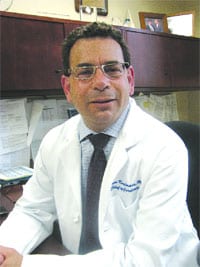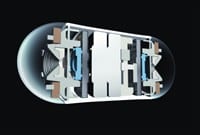Heart of the Matter Baystate Medical Center’s New Chief of Cardiology Doesn’t Miss a Beat
Right now, it’s little more than a very large hole in the ground — one that gets seemingly bigger by the day — but soon, Baystate Health’s so-called Hospital of the Future will start to take shape.
As will the system’s new Heart & Vascular Center, which is being called the centerpiece of the new hospital. And it was the opportunity to lead development of the center that prompted Dr. Aaron Kugelmass to leave a senior staff position at Henry Ford Hospital in Detroit to join Baystate this past spring.
Actually, there were several reasons for the move, Kugelmass told The Healthcare News, but especially the chance to be part of a cardiac program that has gained significant attention — and acclaim — in recent years, and is consistently ranked among the top 5{06cf2b9696b159f874511d23dbc893eb1ac83014175ed30550cfff22781411e5} nationally.
But the new Heart & Vascular Center was perhaps the lead drawing card, said Kugelmass, adding that the facility will be a cutting-edge, patient-focused operation that he hopes will become a model for such operations around the country.
“The Heart & Vascular Center will be both a virtual as well as bricks-and-mortar-based center and program where individuals will receive patient-centered and patient-focused care for both their cardiac and vascular problems,” he explained, stressing a team approach that is somewhat new in the realm of cardiology (more on that later).
Overall, Kugelmass said the science of cardiology has made great strides in the 20 or so years he has been working in this field, and he is excited about what this pace of progress means for the future.
“While cardiovascular disease remains the leading killer of Americans, the strides we’ve made over the past 40 or 50 years have been quite remarkable,” he said, noting, for example, that mortality rates for individuals suffering heart attacks have fallen dramatically. “Thirty years ago, maybe 20{06cf2b9696b159f874511d23dbc893eb1ac83014175ed30550cfff22781411e5} to 25{06cf2b9696b159f874511d23dbc893eb1ac83014175ed30550cfff22781411e5} of all patients who suffered heart attacks wouldn’t leave the hospital; now, at Baystate, only 2.5{06cf2b9696b159f874511d23dbc893eb1ac83014175ed30550cfff22781411e5} won’t survive; that’s real progress.”
Moving forward, he continued, the goal is to reduce that number further, he said, while also reducing the length of hospital stays and improving the quality of life for heart-attack survivors.
This month, as The Healthcare News continues its Today’s Physician series, it turns the spotlight on Kugelmass and Baystate’s cardiac programs and gets to the heart of the matter, literally and figuratively.
In Another Vein
Kugelmass grew up in Storrs, Conn., a college town where many tend to gravitate toward academia. But due largely to the influence of his maternal grandfather and “role model,” Victor Wietzman, a surgeon, Kugelmass instead started down the path into medicine.
After majoring in History at Columbia, he went to another Ivy League institution, Harvard, for medical school, and then opted for the West Coast and, specifically, the University of California at San Francisco for his residency, which he completed in 1989. From there, Kugelmass returned to the Northeast for a fellowship in Cardiology at Beth Israel Hospital and Harvard Medical School.
He later took a job as director of Interventional Cardiology at the University of Oklahoma, where he served for a year before moving on to Henry Ford Hospital, where he wore a number of hats and took a number of titles. They included director of the Cardiac Catheterization Laboratory, associate chief of the Cardiology Division, interim chief of Cardiology Service, and director of the Primary Angioplasty Program.
Kugelmass said he was recruited to come to Baystate, and those doing the bidding had a very attractive package to sell.
Starting with Baystate’s existing cardiac programs, including the so-called ‘door to-balloon’ initiative, which tracks the time that passes between when a patient arrives at Baystate and when a balloon angioplasty is completed and proper blood flow restored.
The Centers for Medicaid Services, the American College of Cardiology, the American Heart Assoc., and other groups have established 90 minutes or less as the optimal door-to-balloon time for heart attack patients.
At Baystate, however, a team approach to accelerating treatment for patients who have a common type of heart attack — referred to as an ST-elevation mydocardial infarction — has resulted in an average door-to-balloon time of 65 minutes, placing it among the top performers in the state and among the top 10{06cf2b9696b159f874511d23dbc893eb1ac83014175ed30550cfff22781411e5} nationally.
“The opportunity to lead a new program — and a program that’s already producing some of the best cardiovascular care in the country — in a geographic location close to where I grew up was irresistible,” said Kugelmass, noting that the ‘door-to-balloon’ effort is only a part of Baystate’s success story.
Kugelmass’s official title now is chief of Cardiology and medical director of the Heart & Vascular Center, and with it comes a formal job description with a number of components.
They include, for the former, directing, or supervising, clinical and academic activities for the Division of Cardiology, including both full-time hospital employee positions as well as affiliated practice physicians; the teaching activities of the division, involving residents, fellows, and medical students; and research activities within the division, including at least 20 clinical trials going on at any given time. These involve everything from new medications to procedures; from devices for angioplasty to new methods of imaging the heart, he said.
As for the Heart & Vascular Center, it remains a vision, and a plan still taking shape, said Kugelmass, adding that he and his colleagues are energized by the opportunity to blueprint such a facility and guide it to reality.
He said there is no one existing facility that Baystate will try to replicate, but rather several centers from which it may take concepts and inspiration, especially with regard to the patient-focused environment that intend to create.
“For many many years, we in medicine divided disease management along departmental lines,” he said as he explained a new approach that will guide operations at the center. “What we’re trying to do here is base care around the patients themselves.
“The same disease processes that cause heart attacks are often involved with development of strokes or other problems throughout the body. We want to come up with a team of physicians and other care providers to focus on the patient and come up with the best overall diagnosis and treatment plan for that patient, rather than have that plan be dependent on which physician the patient sees.”
Roughly 15{06cf2b9696b159f874511d23dbc893eb1ac83014175ed30550cfff22781411e5} of those individuals who have heart disease also have vascular problems, he continued, adding that the new center will focus on the totality of those issues.
“The Heart and Vascular Center is focused on bringing together the right doctors, the right tests, procedures, and therapies at the right time in that patient’s chronology of health and disease, from prevention to procedures,” he said, “and have that focused on the patient, rather than having the whole episode of care focused around the individual practicing physician.”
Taking the Pulse
Looking forward to the future of cardiac and vascular care, Kugelmass said that, while considerable progress has been made in recent years in both the treatment and prevention of heart-health issues, those in this field will face some stern challenges down the road — from the aging of the population to the ongoing and quite troubling obesity problem facing the nation, to the soaring costs of health care and the urgent need to control them.
“The obesity issue poses a challenge not just with regard to heart attacks, but for overall cardiovascular health and other health issues as well,” he told The Healthcare News. “We may have really learned how to fine-tune our treatment of the disease, but the obesity issue is going to increase in incidence.”
Meanwhile, he continued, those in the field will be tasked with treating the huge numbers of heart-attack survivors and their damaged hearts, as well as the rhythm disturbances of an aging population and the myriad problems that will result from a population challenged by obesity and inactivity.
“And the greatest challenge is doing of all that and appropriating the latest technological advanacements in a cost-effective, value-based manner,” he continued. “We can’t deny people what they need … we just have to do it in a more-efficient manner.”
All these are matters to be addressed in the new Heart & Vascular Center, soon to take shape in that giant hole in the ground.



Comments are closed.